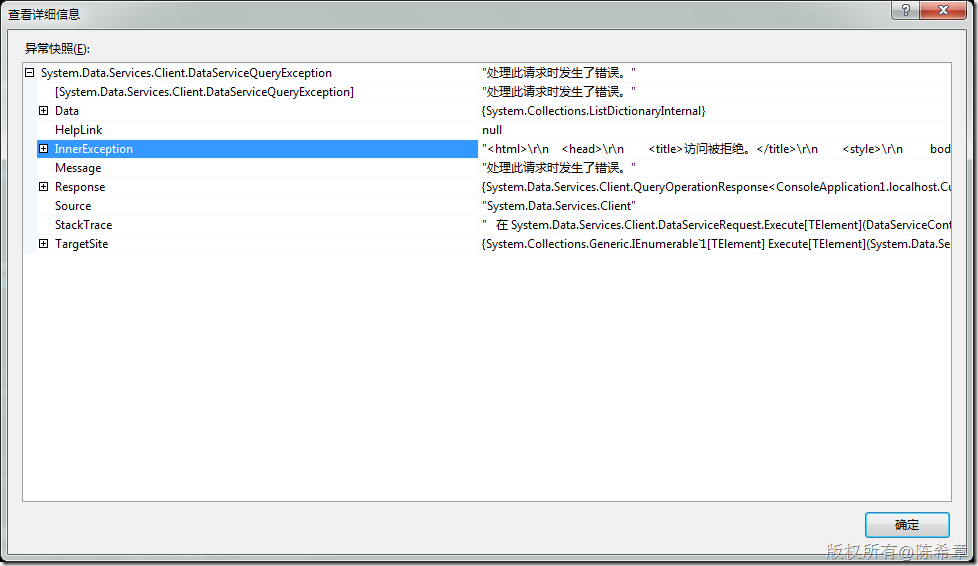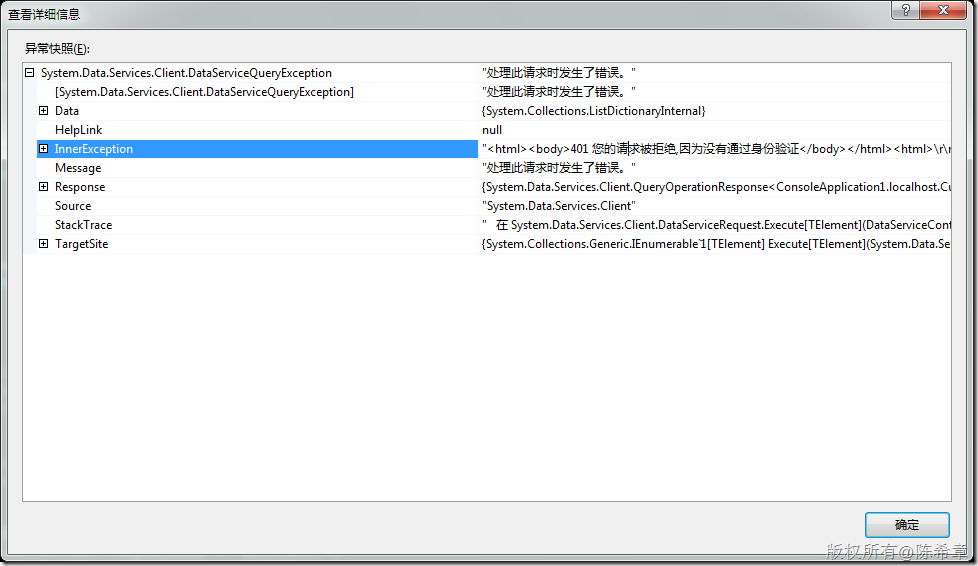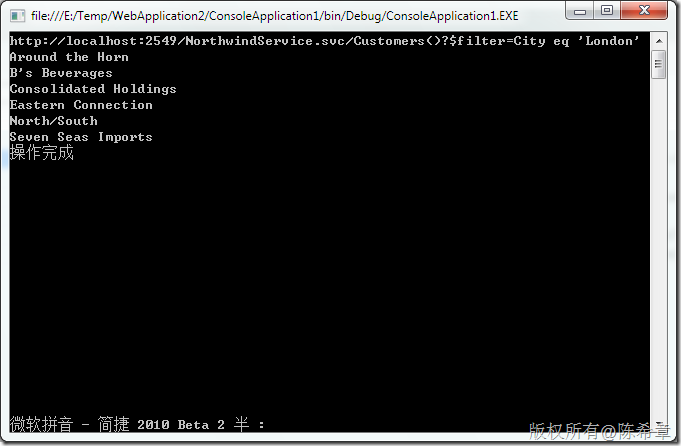ADO.NET Data Service是基于WCF的一套REST风格的服务,但是它在很多方面又与WCF很不一样,典型的情况就是在身份验证方面。这篇文章专门来说一说如何为其实现身份验证。
1. 采用Windows验证方式。
这种方式总是最简单也是最安全的。基本上我们也无需做太多事情。
web.config中配置
<authentication mode="Windows"/>
<authorization>
<allow users="Chenxizhang-pc\chenxizhang"/>
<deny users="*"/>
</authorization>
Data Service里面,我们要通过所谓的QueryInterceptor进行拦截
[QueryInterceptor("Customers")]
public Expression<Func<Customers, bool>> OnQueryCustomers()
{
if (!HttpContext.Current.User.Identity.IsAuthenticated)
throw new AuthenticationException();
else
return (c) => true;
}这样,我们就实现了目的:该服务(或者说其他的网站资源),只允许Chenxizhang-pc\chenxizhang这个账号能访问到。
接下来,客户端中应该怎么做呢?
localhost.NorthwindEntities context = new localhost.NorthwindEntities(
new Uri("http://localhost:2549/NorthwindService.svc/"));
context.Credentials = System.Net.CredentialCache.DefaultNetworkCredentials;
////查询
var query = from c in context.Customers
where c.City.Equals("London")
select c;
Console.WriteLine(query.ToString());
foreach (var item in query)
{
Console.WriteLine(item.CompanyName);
}现在我的身份是合法的,所以能看到结果 但是如果我把下面这一句去除掉<allow users="Chenxizhang-pc\chenxizhang"/>就会发生一个错误
很好,我们这样就实现了身份验证了。等一下,这样是否就真的万事大吉了呢?大家要知道,不是任何场合都有机会使用Windows验证的,例如在internet上,可能就无法使用Windows验证方式。那么,是不是可以使用传统的Forms验证呢?如果在一个网站内部,那么看起来确实可以:先让用户去一个页面(Login.aspx)进行登录,此时它的凭据会保存起来,然后再访问服务的话就拥有了身份。但是,问题是,如果仅仅在网站内部使用,那么有什么必要用Data Service呢?为什么不直接用EDM去存取数据库呢? 好吧,那么,如果我们既希望在外部能访问到这个Data Service,又不想用Windows 验证,并且我们也无法使用Forms验证,那么该怎么办呢?答案是自定义验证。首先,我们编写一个HttpModuleusing System;
using System.Collections.Generic;
using System.Linq;
using System.Text;
using System.Web;
using System.Security.Principal;
namespace DataServiceAuthenticationModule
{
public class AuthenticationModule : IHttpModule
{
const string accessDeniedStatus = "拒绝访问";
const string accessDeniedHtml = "<html><body>401 您的请求被拒绝,因为没有通过身份验证</body></html>";
const string realmFormatString = "Basic realm=\"{0}\"";
const string authServerHeader = "WWW-Authenticate";
const string authClientHeader = "Authorization";
const string basicAuth = "Basic";
#region IHttpModule 成员
public void Dispose()
{
}
public void Init(HttpApplication context)
{
context.AuthenticateRequest += new EventHandler(context_AuthenticateRequest);
}
void context_AuthenticateRequest(object sender, EventArgs e)
{
HttpApplication context = (HttpApplication)sender;
if (context.Request.Headers["Authorization"] == null)
{
context.Response.StatusCode = 401;
context.Response.StatusDescription = accessDeniedStatus;
context.Response.Write(accessDeniedHtml);
// TODO: not sure this is quite right wrt realm.
context.Response.AddHeader(authServerHeader,string.Format(realmFormatString,context.Request.Url.GetLeftPart(UriPartial.Authority)));
}
else
{
string credential = ASCIIEncoding.ASCII.GetString(Convert.FromBase64String(GetBase64CredentialsFromHeader()));
string[] usernameandpassword = credential.Split(':');
context.Context.User= new MyPrinciple(
new MyIdentity(usernameandpassword[0], Authenticate(usernameandpassword[0], usernameandpassword[1])));
}
}
bool Authenticate(string username, string password)
{
//your code logic here to authenticate user
if (username !="chenxizhang" || password!="password") return false;
else
return true;
}
string GetBase64CredentialsFromHeader()
{
string credsHeader =HttpContext.Current.Request.Headers[authClientHeader];
string creds = null;
int credsPosition =
credsHeader.IndexOf(basicAuth, StringComparison.OrdinalIgnoreCase);
if (credsPosition != -1)
{
credsPosition += basicAuth.Length + 1;
creds = credsHeader.Substring(credsPosition,
credsHeader.Length - credsPosition);
}
return (creds);
}
#endregion
}
public class MyPrinciple : IPrincipal
{
private IIdentity _id;
public MyPrinciple(IIdentity id)
{
_id = id;
}
public IIdentity Identity
{
get { return _id; }
}
public bool IsInRole(string role)
{
throw new NotImplementedException();
}
}
public class MyIdentity : IIdentity
{
private bool _isAuthenticated = false;
private string _name;
public MyIdentity(string name, bool isAuthenticated)
{
_isAuthenticated = isAuthenticated;
_name = name;
}
public string AuthenticationType
{
get { throw new NotImplementedException(); }
}
public bool IsAuthenticated
{
get { return _isAuthenticated; }
}
public string Name
{
get { return _name; }
}
}
}
然后,我们将web.config中的身份验证模式改为不验证(也就是说由我们自定义验证)
<authentication mode="None"/>
然后,我们将上面这个模块注册到配置文件中
<add name="DataServiceAuthentication" type="DataServiceAuthenticationModule.AuthenticationModule,DataServiceAuthenticationModule"/>配置好之后,我们再次运行一下客户端,收到了如下的错误。这一点都不奇怪,因为我们并没有传递身份过来。
那么客户端应该如何传递身份呢
context.Credentials = new System.Net.NetworkCredential("chenxizhang", "password");
这样的话,我们就能如愿看到结果了
写到这里,我想很多朋友就看明白了,我们做了一个自定义的HttpModule,接管了请求的身份验证过程。那么现在的做法是直接比较用户名和密码,是不是很不合理呢?当然,正式的环境下我们不能这么做,但是你既然拿到了username,和password,其实你要怎么验证都不重要了。 






 本文详细阐述了如何在ADO.NET Data Service中实现自定义身份验证,包括使用Windows验证、Forms验证以及自定义HttpModule的方式。通过配置web.config文件、编写HttpModule和正确传递客户端身份,实现了对服务的访问控制。
本文详细阐述了如何在ADO.NET Data Service中实现自定义身份验证,包括使用Windows验证、Forms验证以及自定义HttpModule的方式。通过配置web.config文件、编写HttpModule和正确传递客户端身份,实现了对服务的访问控制。




















 37
37

 被折叠的 条评论
为什么被折叠?
被折叠的 条评论
为什么被折叠?








